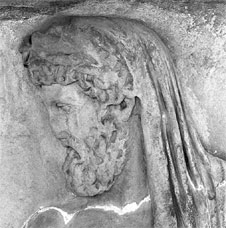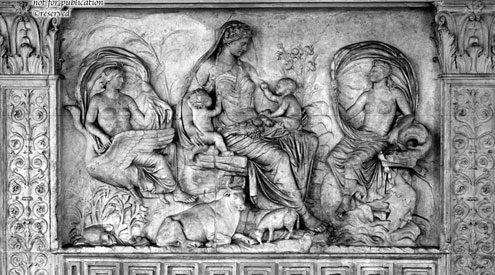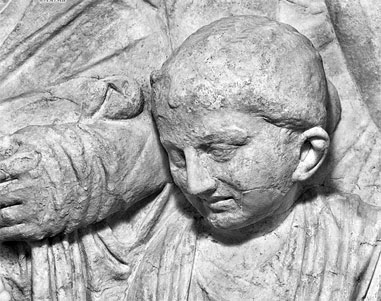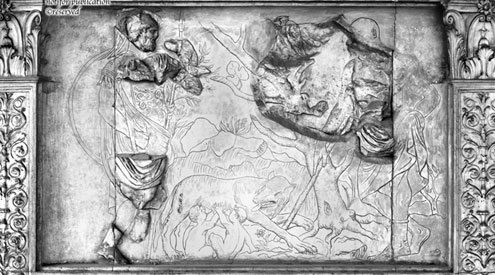Rather than a simple tribute to peace, the altar instead creates a representation of the Pax Romana championed by Augustus. Oddly enough, any representation of Pax, the goddess of peace, is not fully agreed upon in the Ara Pacis. The theme of peace is most directly linked with the image of a woman, possibly representing Pax (Goddess of Peace), Venus Genetrix (Mother of the Julian family), Tellus (Mother Earth), Terra (land), or a general representation of Italia. Most likely the figure is representative of all the aforementioned entities (Cooley 232).
This duality of war and peace is re-emphasized on the western wall of the Ara Pacis. The depiction of Aeneas offering sacrifices to his own Di Penates (household deities) celebrates both Aeneas' arrival to his new home in Italy as well as Augustus' return from Spain. Both of these homecomings are associated with finding peace anew after war; Aeneas from the Trojan War and Augustus from the pacification of the provinces. Contrasting the theme of return from war is the likeness of Mars (God of War) standing prominently over his sons Romulus and Remus. Mars represents war itself while the two brothers, destined towards fratricide, represent the folly and tragedy of civil war Augustus had finally settled.
Children are featured very prominently throughout the relief on the Ara Pacis. In the depictions of the imperial and senatorial families attending a religious ceremony, children are depicted tugging at their mother's dress. They wiggle and squirm, visually uncomfortable. The universal theme of children growing anxious and restless through religious functions, unfounded prior to the construction of the Ara Pacis, held great appeal and would be widely imitated in middle-class funerary artwork soon after (Galinsky 150). By depicting children as well as women, the Altar has an informal and humanistic side not found in the rigidly formal and militaristic friezes found on other monuments. Although the original faces have been lost, the faces of the those depicted all have soft expressions, like real people. The people depicted have flaws, even needing to be silenced by one attendee for talking too loudly.
Children are also found in the depiction of the mythical tale of Romulus and Remus being nursed by a she-wolf on the western wall. This very familiar and popular motif undoubtedly resonated with those who viewed the altar. Augustus promoted solid family mores by encouraging upper-class families to have children. Population growth was the key to future Roman imperium. This is represented by large number of children represented on such a monument, and reinforced by having children present in the Tellus panel representing fertility.
The front right panel shows Aeneas rescuing his father and son from Troy. Aside from Aeneas's connection as the founder of Rome and an ancestor of Augustus, it reinforces the idea of Augustus's filial piety. (Farber) Aeneas went back into a burning Troy to rescue his father and son. Augustus is aiming to connect himself by example and show his devotion to his (adopted) father Julius Caesar. Aeneas's father is wearing his cloak over his head, in addition to wearing a laurel wreath. The laurels wreath is a classic symbol of Julius Caesar. By linking himself in this way, he also justifies some of his early political actions which tended to be brutal as avenging his father. Indeed, in his Res Gestae he attributes his raising of an army as a private citizen to "avenge his father."
This interpretation is not necessarily the most common interpretation of the scene (most scholars understand it to be Aeneas sacrificing). But like many of the images on the Ara Pacis, the image is likely intentionally ambiguous to allow to a depth of meanings and interpretations.
This detailed panel of Aeneas shows him wearing the laurels wreath which is a classical symbol of Julius Caesar.
The informal nature of the procession. Notice the depiction of the children, and the person quieting the procession in the top left corner.
She sits amongst bountiful harvests and represent fertility by suckling two children. These ideas of "fertility and bountifulness" emphasize the "blessings of a tranquil time" (Bowman 194). Less prominent, the likeness of Roma (Goddess of war) sits atop a pile of arms and armor, along with Honos and Virtus (representations of honor and valor during battle). The two images, taken together represent the dependence of peace on victory in war. (Bowman 194). Augustus, being the military leader, is the reason for victory in war. Since the peace is dependent on victory, Augustus is also the cause for peace, substantiating the implicit.





